Abstract
1. The conversion of haloperidol (HAL) to reduced haloperidol (RHAL) and then back to HAL has been established in vivo and observed in psychiatric patients. The reduction of HAL to RHAL is known to be catalysed by a ketone reductase, while the nature of oxidation back to HAL is the subject of the present study. 2. We examined the in vitro oxidation of RHAL to HAL in human livers. The activity was microsomal and evidence is presented to suggest that the sparteine/debrisoquine metabolizing isoenzyme P450IID6 contributes to this oxidation. 3. Reciprocal inhibition studies between RHAL and sparteine, a specific substrate for cytochrome P450IID6, indicated that both compounds compete for the same binding site. Quinidine, the most specific inhibitor for this cytochrome P450 potently inhibited the oxidative conversion of reduced haloperidol to haloperidol. A significant correlation (rs = 0.62, P less than 0.01) was found between RHAL oxidation and sparteine oxidation in a study involving 17 human liver samples.
Full text
PDF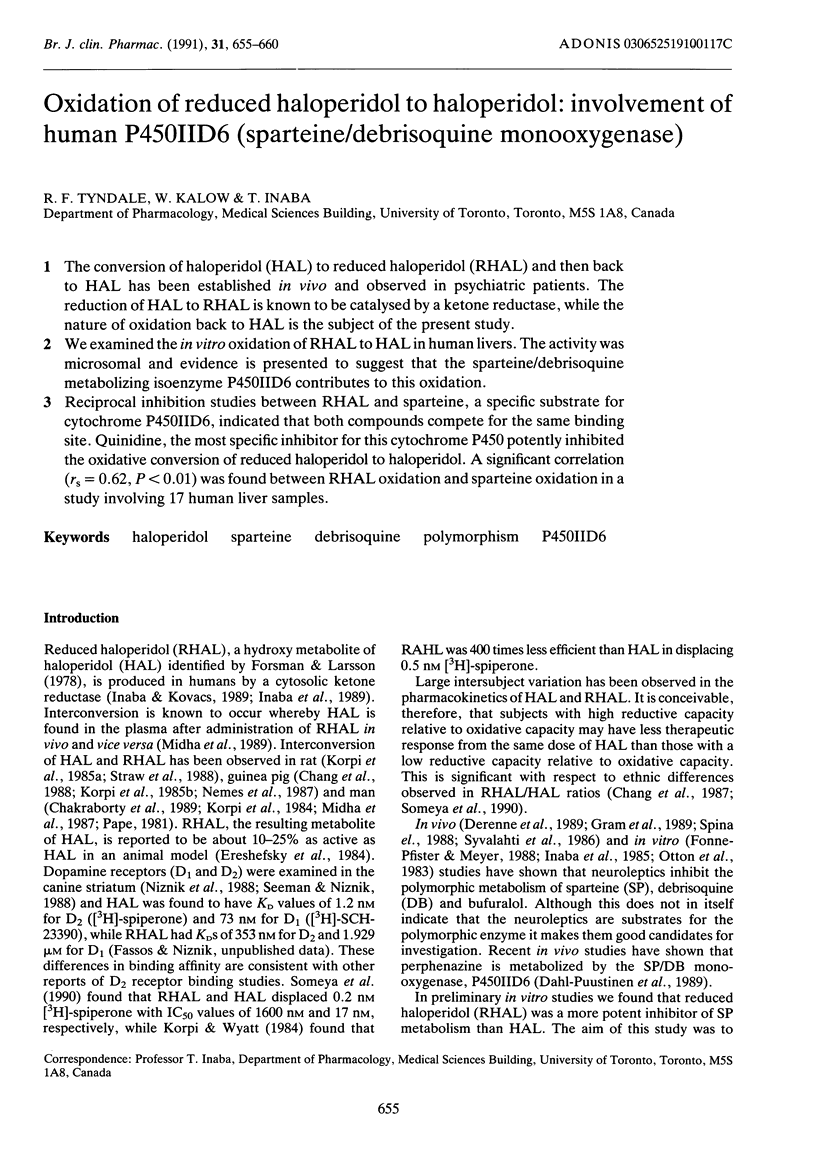
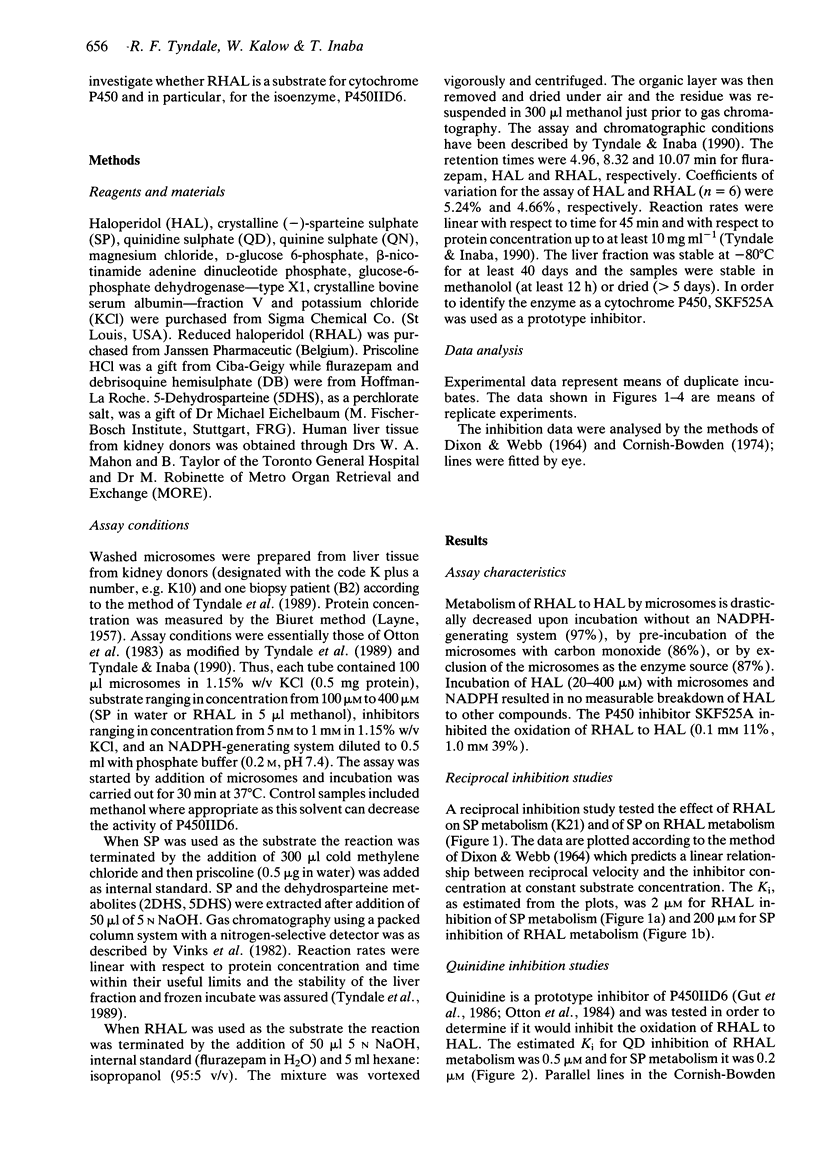
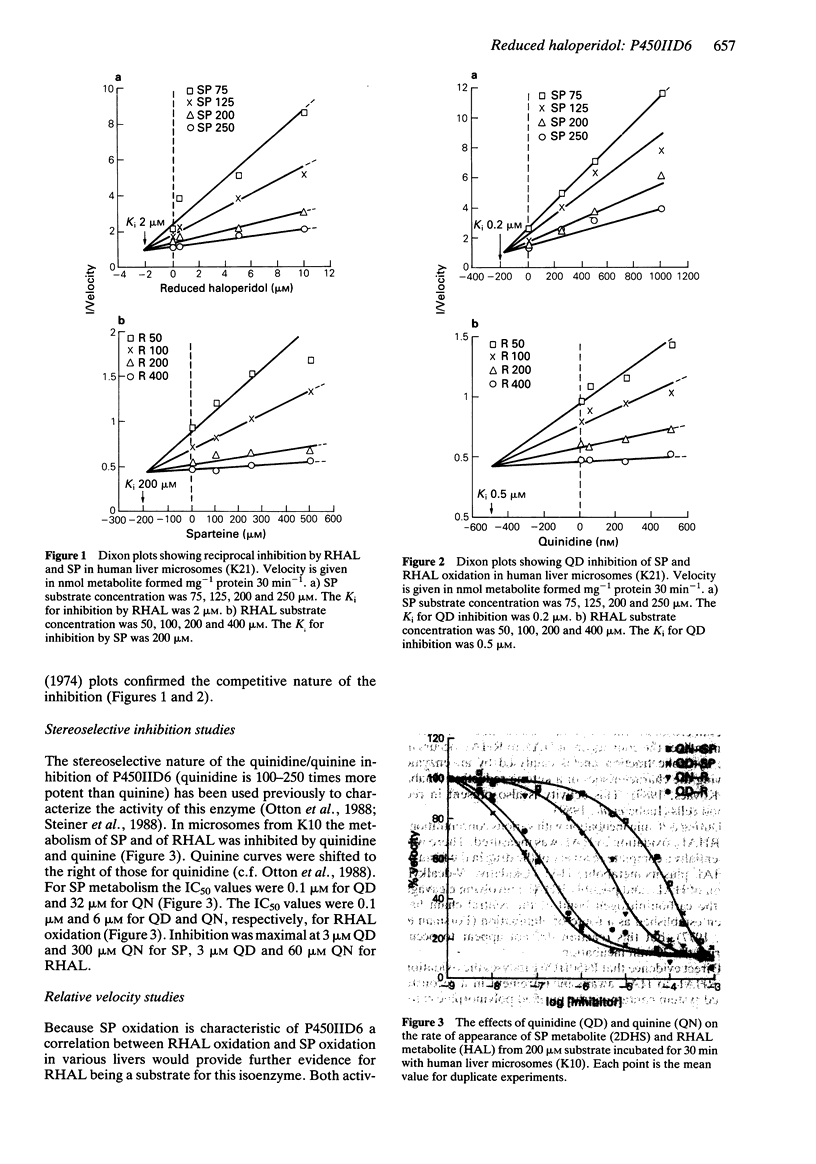
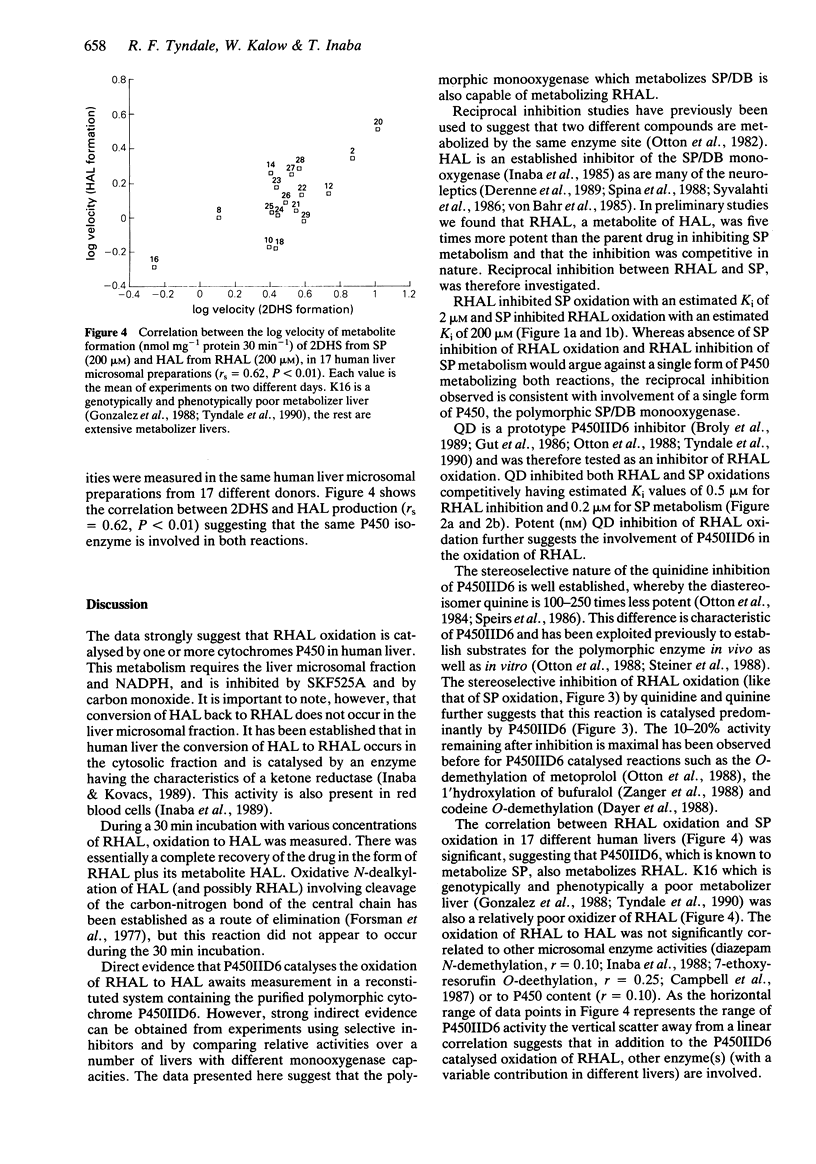
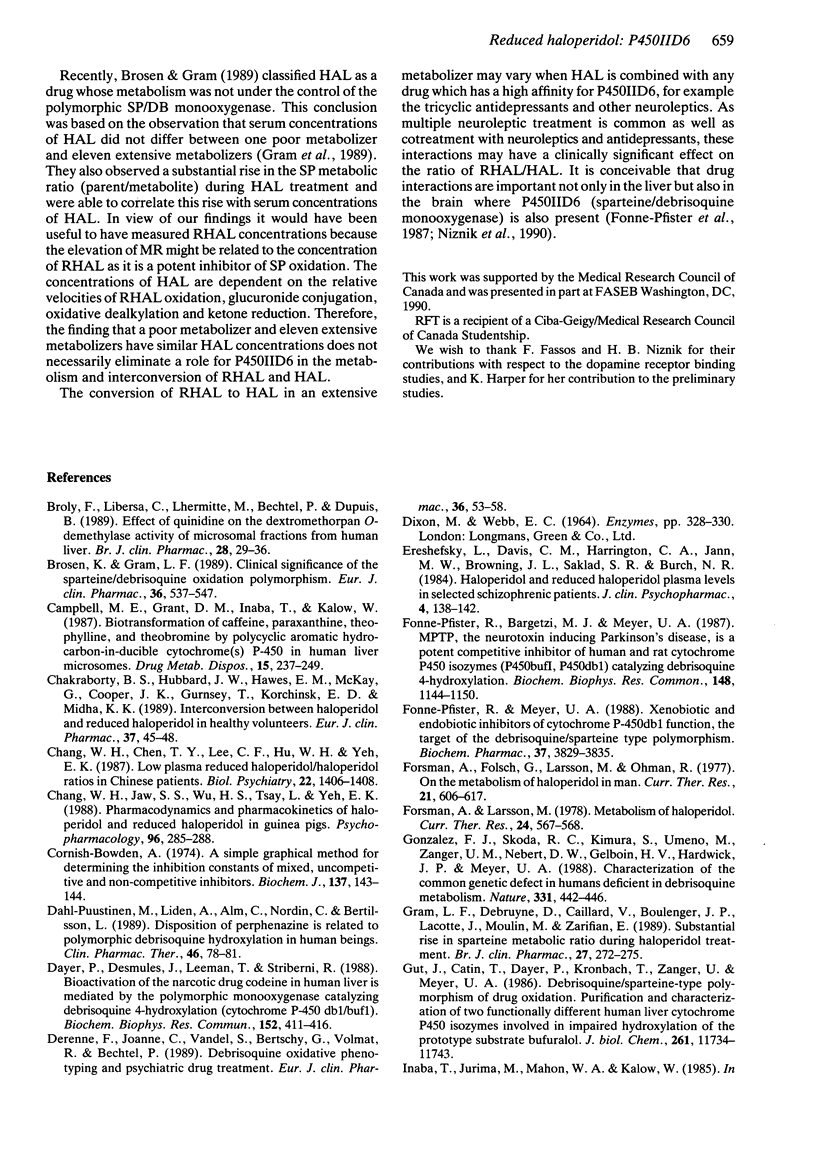
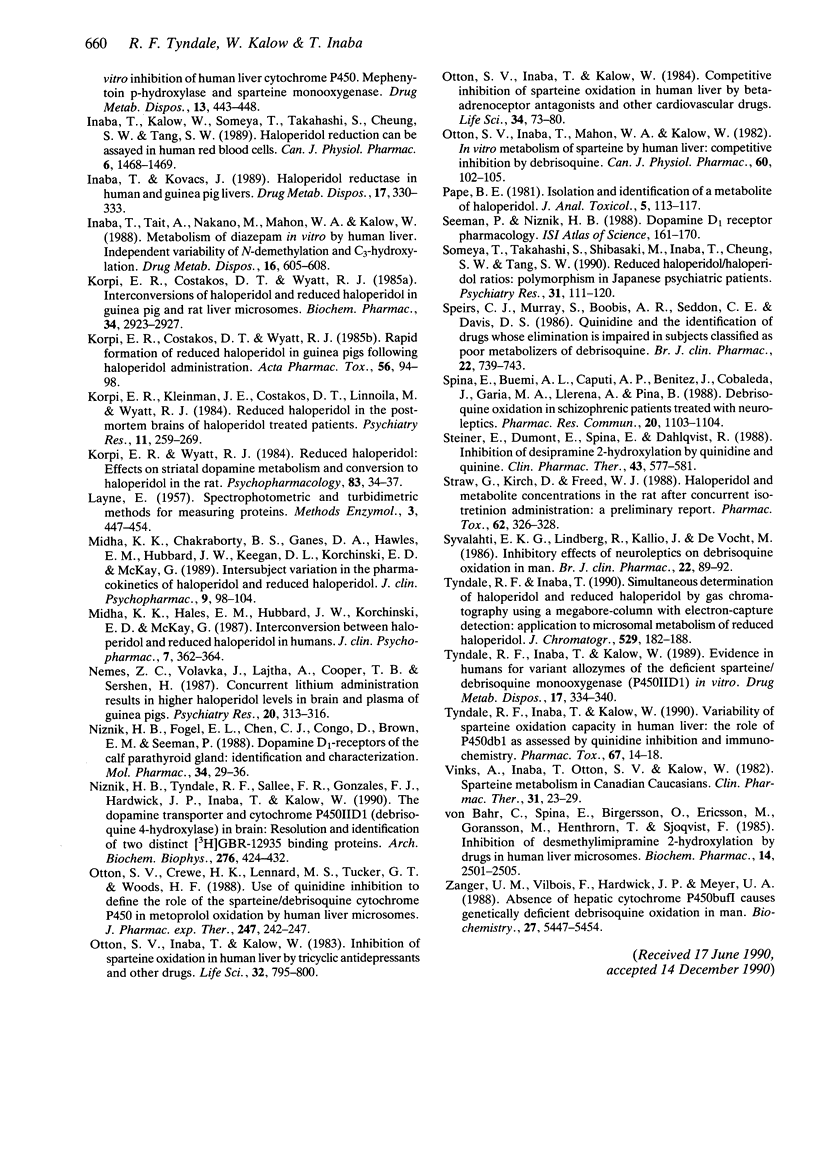
Selected References
These references are in PubMed. This may not be the complete list of references from this article.
- Broly F., Libersa C., Lhermitte M., Bechtel P., Dupuis B. Effect of quinidine on the dextromethorphan O-demethylase activity of microsomal fractions from human liver. Br J Clin Pharmacol. 1989 Jul;28(1):29–36. doi: 10.1111/j.1365-2125.1989.tb03502.x. [DOI] [PMC free article] [PubMed] [Google Scholar]
- Brøsen K., Gram L. F. Clinical significance of the sparteine/debrisoquine oxidation polymorphism. Eur J Clin Pharmacol. 1989;36(6):537–547. doi: 10.1007/BF00637732. [DOI] [PubMed] [Google Scholar]
- Campbell M. E., Grant D. M., Inaba T., Kalow W. Biotransformation of caffeine, paraxanthine, theophylline, and theobromine by polycyclic aromatic hydrocarbon-inducible cytochrome(s) P-450 in human liver microsomes. Drug Metab Dispos. 1987 Mar-Apr;15(2):237–249. [PubMed] [Google Scholar]
- Chakraborty B. S., Hubbard J. W., Hawes E. M., McKay G., Cooper J. K., Gurnsey T., Korchinski E. D., Midha K. K. Interconversion between haloperidol and reduced haloperidol in healthy volunteers. Eur J Clin Pharmacol. 1989;37(1):45–48. doi: 10.1007/BF00609423. [DOI] [PubMed] [Google Scholar]
- Chang W. H., Chen T. Y., Lee C. F., Hu W. H., Yeh E. K. Low plasma reduced haloperidol/haloperidol ratios in Chinese patients. Biol Psychiatry. 1987 Nov;22(11):1406–1408. doi: 10.1016/0006-3223(87)90074-6. [DOI] [PubMed] [Google Scholar]
- Chang W. H., Jaw S. S., Wu H. S., Tsay L., Yeh E. K. Pharmacodynamics and pharmacokinetics of haloperidol and reduced haloperidol in guinea pigs. Psychopharmacology (Berl) 1988;96(3):285–288. doi: 10.1007/BF00216051. [DOI] [PubMed] [Google Scholar]
- Cornish-Bowden A. A simple graphical method for determining the inhibition constants of mixed, uncompetitive and non-competitive inhibitors. Biochem J. 1974 Jan;137(1):143–144. doi: 10.1042/bj1370143. [DOI] [PMC free article] [PubMed] [Google Scholar]
- Dahl-Puustinen M. L., Lidén A., Alm C., Nordin C., Bertilsson L. Disposition of perphenazine is related to polymorphic debrisoquin hydroxylation in human beings. Clin Pharmacol Ther. 1989 Jul;46(1):78–81. doi: 10.1038/clpt.1989.109. [DOI] [PubMed] [Google Scholar]
- Dayer P., Desmeules J., Leemann T., Striberni R. Bioactivation of the narcotic drug codeine in human liver is mediated by the polymorphic monooxygenase catalyzing debrisoquine 4-hydroxylation (cytochrome P-450 dbl/bufI). Biochem Biophys Res Commun. 1988 Apr 15;152(1):411–416. doi: 10.1016/s0006-291x(88)80729-0. [DOI] [PubMed] [Google Scholar]
- Derenne F., Joanne C., Vandel S., Bertschy G., Volmat R., Bechtel P. Debrisoquine oxidative phenotyping and psychiatric drug treatment. Eur J Clin Pharmacol. 1989;36(1):53–58. doi: 10.1007/BF00561023. [DOI] [PubMed] [Google Scholar]
- Ereshefsky L., Davis C. M., Harrington C. A., Jann M. W., Browning J. L., Saklad S. R., Burch N. R. Haloperidol and reduced haloperidol plasma levels in selected schizophrenic patients. J Clin Psychopharmacol. 1984 Jun;4(3):138–142. [PubMed] [Google Scholar]
- Fonne-Pfister R., Bargetzi M. J., Meyer U. A. MPTP, the neurotoxin inducing Parkinson's disease, is a potent competitive inhibitor of human and rat cytochrome P450 isozymes (P450bufI, P450db1) catalyzing debrisoquine 4-hydroxylation. Biochem Biophys Res Commun. 1987 Nov 13;148(3):1144–1150. doi: 10.1016/s0006-291x(87)80252-8. [DOI] [PubMed] [Google Scholar]
- Fonne-Pfister R., Meyer U. A. Xenobiotic and endobiotic inhibitors of cytochrome P-450dbl function, the target of the debrisoquine/sparteine type polymorphism. Biochem Pharmacol. 1988 Oct 15;37(20):3829–3835. doi: 10.1016/0006-2952(88)90063-9. [DOI] [PubMed] [Google Scholar]
- Gonzalez F. J., Skoda R. C., Kimura S., Umeno M., Zanger U. M., Nebert D. W., Gelboin H. V., Hardwick J. P., Meyer U. A. Characterization of the common genetic defect in humans deficient in debrisoquine metabolism. Nature. 1988 Feb 4;331(6155):442–446. doi: 10.1038/331442a0. [DOI] [PubMed] [Google Scholar]
- Gram L. F., Debruyne D., Caillard V., Boulenger J. P., Lacotte J., Moulin M., Zarifian E. Substantial rise in sparteine metabolic ratio during haloperidol treatment. Br J Clin Pharmacol. 1989 Feb;27(2):272–275. doi: 10.1111/j.1365-2125.1989.tb05362.x. [DOI] [PMC free article] [PubMed] [Google Scholar]
- Gut J., Catin T., Dayer P., Kronbach T., Zanger U., Meyer U. A. Debrisoquine/sparteine-type polymorphism of drug oxidation. Purification and characterization of two functionally different human liver cytochrome P-450 isozymes involved in impaired hydroxylation of the prototype substrate bufuralol. J Biol Chem. 1986 Sep 5;261(25):11734–11743. [PubMed] [Google Scholar]
- Inaba T., Jurima M., Mahon W. A., Kalow W. In vitro inhibition studies of two isozymes of human liver cytochrome P-450. Mephenytoin p-hydroxylase and sparteine monooxygenase. Drug Metab Dispos. 1985 Jul-Aug;13(4):443–448. [PubMed] [Google Scholar]
- Inaba T., Kalow W., Someya T., Takahashi S., Cheung S. W., Tang S. W. Haloperidol reduction can be assayed in human red blood cells. Can J Physiol Pharmacol. 1989 Nov;67(11):1468–1469. doi: 10.1139/y89-237. [DOI] [PubMed] [Google Scholar]
- Inaba T., Kovacs J. Haloperidol reductase in human and guinea pig livers. Drug Metab Dispos. 1989 May-Jun;17(3):330–333. [PubMed] [Google Scholar]
- Inaba T., Tait A., Nakano M., Mahon W. A., Kalow W. Metabolism of diazepam in vitro by human liver. Independent variability of N-demethylation and C3-hydroxylation. Drug Metab Dispos. 1988 Jul-Aug;16(4):605–608. [PubMed] [Google Scholar]
- Korpi E. R., Costakos D. T., Wyatt R. J. Interconversions of haloperidol and reduced haloperidol in guinea pig and rat liver microsomes. Biochem Pharmacol. 1985 Aug 15;34(16):2923–2927. doi: 10.1016/0006-2952(85)90017-6. [DOI] [PubMed] [Google Scholar]
- Korpi E. R., Costakos D. T., Wyatt R. J. Rapid formation of reduced haloperidol in guinea pigs following haloperidol administration. Acta Pharmacol Toxicol (Copenh) 1985 Feb;56(2):94–98. doi: 10.1111/j.1600-0773.1985.tb01260.x. [DOI] [PubMed] [Google Scholar]
- Korpi E. R., Kleinman J. E., Costakos D. T., Linnoila M., Wyatt R. J. Reduced haloperidol in the post-mortem brains of haloperidol-treated patients. Psychiatry Res. 1984 Mar;11(3):259–269. doi: 10.1016/0165-1781(84)90074-x. [DOI] [PubMed] [Google Scholar]
- Korpi E. R., Wyatt R. J. Reduced haloperidol: effects on striatal dopamine metabolism and conversion to haloperidol in the rat. Psychopharmacology (Berl) 1984;83(1):34–37. doi: 10.1007/BF00427418. [DOI] [PubMed] [Google Scholar]
- Midha K. K., Chakraborty B. S., Ganes D. A., Hawes E. M., Hubbard J. W., Keegan D. L., Korchinski E. D., McKay G. Intersubject variation in the pharmacokinetics of haloperidol and reduced haloperidol. J Clin Psychopharmacol. 1989 Apr;9(2):98–104. doi: 10.1097/00004714-198904000-00005. [DOI] [PubMed] [Google Scholar]
- Midha K. K., Hawes E. M., Hubbard J. W., Korchinski E. D., McKay G. Interconversion between haloperidol and reduced haloperidol in humans. J Clin Psychopharmacol. 1987 Oct;7(5):362–364. [PubMed] [Google Scholar]
- Nemes Z. C., Volavka J., Lajtha A., Cooper T. B., Sershen H. Concurrent lithium administration results in higher haloperidol levels in brain and plasma of guinea pigs. Psychiatry Res. 1987 Apr;20(4):313–316. doi: 10.1016/0165-1781(87)90092-8. [DOI] [PubMed] [Google Scholar]
- Niznik H. B., Fogel E. L., Chen C. J., Congo D., Brown E. M., Seeman P. Dopamine D1 receptors of the calf parathyroid gland: identification and characterization. Mol Pharmacol. 1988 Jul;34(1):29–36. [PubMed] [Google Scholar]
- Niznik H. B., Tyndale R. F., Sallee F. R., Gonzalez F. J., Hardwick J. P., Inaba T., Kalow W. The dopamine transporter and cytochrome P45OIID1 (debrisoquine 4-hydroxylase) in brain: resolution and identification of two distinct [3H]GBR-12935 binding proteins. Arch Biochem Biophys. 1990 Feb 1;276(2):424–432. doi: 10.1016/0003-9861(90)90741-g. [DOI] [PubMed] [Google Scholar]
- Otton S. V., Crewe H. K., Lennard M. S., Tucker G. T., Woods H. F. Use of quinidine inhibition to define the role of the sparteine/debrisoquine cytochrome P450 in metoprolol oxidation by human liver microsomes. J Pharmacol Exp Ther. 1988 Oct;247(1):242–247. [PubMed] [Google Scholar]
- Otton S. V., Inaba T., Kalow W. Competitive inhibition of sparteine oxidation in human liver by beta-adrenoceptor antagonists and other cardiovascular drugs. Life Sci. 1984 Jan 2;34(1):73–80. doi: 10.1016/0024-3205(84)90332-1. [DOI] [PubMed] [Google Scholar]
- Otton S. V., Inaba T., Kalow W. Inhibition of sparteine oxidation in human liver by tricyclic antidepressants and other drugs. Life Sci. 1983 Feb 14;32(7):795–800. doi: 10.1016/0024-3205(83)90315-6. [DOI] [PubMed] [Google Scholar]
- Otton S. V., Inaba T., Mahon W. A., Kalow W. In vitro metabolism of sparteine by human liver: competitive inhibition by debrisoquine. Can J Physiol Pharmacol. 1982 Jan;60(1):102–105. doi: 10.1139/y82-017. [DOI] [PubMed] [Google Scholar]
- Pape B. E. Isolation and identification of a metabolite of haloperidol. J Anal Toxicol. 1981 May-Jun;5(3):113–117. doi: 10.1093/jat/5.3.113. [DOI] [PubMed] [Google Scholar]
- Someya T., Takahashi S., Shibasaki M., Inaba T., Cheung S. W., Tang S. W. Reduced haloperidol/haloperidol ratios in plasma: polymorphism in Japanese psychiatric patients. Psychiatry Res. 1990 Feb;31(2):111–120. doi: 10.1016/0165-1781(90)90114-k. [DOI] [PubMed] [Google Scholar]
- Speirs C. J., Murray S., Boobis A. R., Seddon C. E., Davies D. S. Quinidine and the identification of drugs whose elimination is impaired in subjects classified as poor metabolizers of debrisoquine. Br J Clin Pharmacol. 1986 Dec;22(6):739–743. doi: 10.1111/j.1365-2125.1986.tb02969.x. [DOI] [PMC free article] [PubMed] [Google Scholar]
- Spina E., Buemi A. L., Caputi A. P., Benitez J., Cobaleda J., Garcia M. A., Llerena A., Piña B. Debrisoquine oxidation in schizophrenic patients treated with neuroleptics. Pharmacol Res Commun. 1988 Dec;20(12):1103–1104. doi: 10.1016/s0031-6989(88)80747-1. [DOI] [PubMed] [Google Scholar]
- Steiner E., Dumont E., Spina E., Dahlqvist R. Inhibition of desipramine 2-hydroxylation by quinidine and quinine. Clin Pharmacol Ther. 1988 May;43(5):577–581. doi: 10.1038/clpt.1988.76. [DOI] [PubMed] [Google Scholar]
- Straw G., Kirch D., Freed W. J. Haloperidol and metabolite concentrations in the rat after concurrent isotretinoin administration: a preliminary report. Pharmacol Toxicol. 1988 May;62(5):326–328. doi: 10.1111/j.1600-0773.1988.tb01897.x. [DOI] [PubMed] [Google Scholar]
- Syvälahti E. K., Lindberg R., Kallio J., De Vocht M. Inhibitory effects of neuroleptics on debrisoquine oxidation in man. Br J Clin Pharmacol. 1986 Jul;22(1):89–92. [PMC free article] [PubMed] [Google Scholar]
- Tyndale R. F., Gonzalez F. J., Hardwick J. P., Kalow W., Inaba T. Sparteine metabolism capacity in human liver: structural variants of human P450IID6 as assessed by immunochemistry. Pharmacol Toxicol. 1990 Jul;67(1):14–18. doi: 10.1111/j.1600-0773.1990.tb00774.x. [DOI] [PubMed] [Google Scholar]
- Tyndale R. F., Inaba T., Kalow W. Evidence in humans for variant allozymes of the nondeficient sparteine/debrisoquine monooxygenase (P45OIID 1) in vitro. Drug Metab Dispos. 1989 May-Jun;17(3):334–340. [PubMed] [Google Scholar]
- Tyndale R. F., Inaba T. Simultaneous determination of haloperidol and reduced haloperidol by gas chromatography using a megabore column with electron-capture detection: application to microsomal oxidation of reduced haloperidol. J Chromatogr. 1990 Jul 13;529(1):182–188. doi: 10.1016/s0378-4347(00)83820-7. [DOI] [PubMed] [Google Scholar]
- Vinks A., Inaba T., Otton S. V., Kalow W. Sparteine metabolism in Canadian Caucasians. Clin Pharmacol Ther. 1982 Jan;31(1):23–29. doi: 10.1038/clpt.1982.4. [DOI] [PubMed] [Google Scholar]
- Zanger U. M., Vilbois F., Hardwick J. P., Meyer U. A. Absence of hepatic cytochrome P450bufI causes genetically deficient debrisoquine oxidation in man. Biochemistry. 1988 Jul 26;27(15):5447–5454. doi: 10.1021/bi00415a010. [DOI] [PubMed] [Google Scholar]
- von Bahr C., Spina E., Birgersson C., Ericsson O., Göransson M., Henthorn T., Sjöqvist F. Inhibition of desmethylimipramine 2-hydroxylation by drugs in human liver microsomes. Biochem Pharmacol. 1985 Jul 15;34(14):2501–2505. doi: 10.1016/0006-2952(85)90533-7. [DOI] [PubMed] [Google Scholar]


